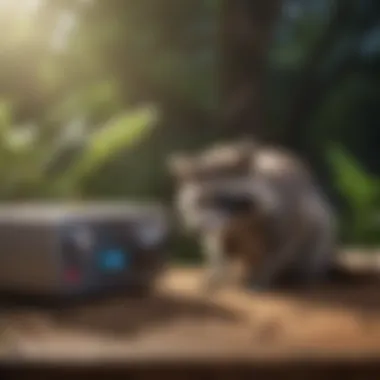Top Ultrasonic Repellents to Keep Raccoons Away


Intro
Ultrasonic repellents have gained attention as a modern solution for managing raccoon intrusion. Homeowners frequently seek methods to protect their spaces from this clever and resourceful pest. Raccoons, with their nocturnal habits and intelligent behavior, can wreak havoc, damaging property and creating unsanitary conditions. Thus, understanding how ultrasonic repellents work is crucial for effective pest management.
In this article, we will delve into the technology underlying ultrasonic devices designed for raccoon deterrence, exploring their effectiveness compared to traditional methods. We will review various products available on the market, considering critical factors such as user feedback and environmental impact. This comprehensive guide aims to help homeowners make informed decisions while also providing practical advice on how to safeguard their residences from raccoons and other pests.
Pest Identification
Identifying the type of pest invading your space is the first step in effective pest control. For homeowners dealing with raccoons, understanding their behavior and signs of infestation can greatly aid in mitigating the problem.
Common Household Pests
Raccoons are not the only pests that homeowners might encounter. Some common household pests include:
- Squirrels
- Skunks
- Opossums
- Rats
- Mice
These animals share similar habitats and feeding habits, making it essential to correctly identify which pest you are dealing with.
Signs of Infestation
Raccoons exhibit specific behaviors that can be helpful to recognize when assessing an infestation.
- Nocturnal Activity: Raccoons are mainly active at night. Unusual noises from the attic or garbage areas after dark may indicate their presence.
- Damage to Outdoor Areas: Look for overturned garbage cans, claw scratches on doors or windows, and disturbed garden landscaping.
- Tracks and Droppings: Raccoon tracks are distinctive, with five toes on each foot. Their droppings are often found near their feeding areas and can vary in size, indicating their diet. Observing these signs is essential to understand the severity of the invasion.
"Acting promptly when spotting these signs can prevent further damage to your property."
Understanding these indicators can better prepare homeowners for selecting the right ultrasonic solution to deal with raccoon problems effectively.
Understanding Raccoons as Pests
Understanding raccoons as pests is crucial for effective pest management. Raccoons exhibit unique behaviors and characteristics which make them particularly challenging to deal with for homeowners. Recognizing these factors helps in selecting appropriate deterrents, such as ultrasonic repellents, which can significantly aid in managing their presence.
Behavior and Habitat
Raccoons are highly adaptable creatures known for their intelligence and resourcefulness. They typically inhabit urban and suburban areas where food is readily available. These animals are nocturnal, meaning they are most active at night. This nocturnal lifestyle often leads them to rummage through garbage cans or seek out pet food left outdoors. Their dexterous front paws allow them to open containers, making them adept at accessing food resources humans often don’t expect.
Raccoons thrive in environments close to water sources such as rivers and lakes. They often build dens in secluded locations, including attics, basements, or even hollow trees. Awareness of their natural behavior and preferred habitats can help homeowners implement preventive measures to deter them effectively.
Common Problems Caused by Raccoons
Raccoons can cause various problems that affect homeowners and the surrounding community. Some of the common issues include:
- Property Damage: Raccoons can cause significant structural damage when they enter homes or buildings. They may tear insulation, chew through wires, and create holes in roofs or walls.
- Health Risks: Raccoons are known carriers of diseases such as rabies and raccoon roundworm. Their droppings can harbor parasites, posing health risks to humans and pets.
- Food Contamination: Raccoons often access bins or pet food containers, leading to contamination of food supplies. Such actions not only waste food but could also lead to health risks from spoiled or tainted food.
"Raccoons are more than just cute pests. Their behavior and adaptability can result in significant issues for households, necessitating effective solutions."
- Noise Disturbances: Their scavenging activities can be loud. Residents may find sleep disruption as raccoons tip over trash cans or fight amongst themselves over food sources.
In summary, understanding raccoons as pests lays the groundwork for addressing their presence effectively. It enables homeowners to make informed decisions regarding preventive measures and makes the exploration of ultrasonic repellents all the more relevant.
Preface to Ultrasonic Repellents
Ultrasonic repellents represent a modern solution to pest control, particularly in managing raccoon encounters. Understanding the principles and functionalities of these devices is crucial for homeowners facing challenges with these nocturnal animals. The relevance of ultrasonic repellents stems from their unique approach to deterrence, utilizing sound frequencies that are inaudible to human ears but effective against raccoons.
Definition and Mechanism


Ultrasonic repellents work by emitting sound waves at frequencies typically above 20 kHz. Raccoons and other pests can detect these high-frequency sounds, which serve to disrupt their communication and navigation. As a result, they may avoid areas where these devices are in operation. Importantly, ultrasonic sound is safe for humans and pets, making it an appealing choice for households.
Moreover, these devices often offer a range of settings that can be tailored to specific environments. This adaptability can enhance effectiveness, as different locations may require varying intensity levels to deter raccoons adequately. Opting for a device with adjustable frequencies might provide a strategic edge in pest control.
Comparison with Traditional Methods
When comparing ultrasonic repellents with traditional pest control methods, several factors merit consideration. Conventional methods often involve traps or poisons, which can pose risks to non-target animals and raise ethical concerns. In contrast, ultrasonic repellents provide a humane solution that minimizes environmental impact.
- Efficacy: Traditional methods can certainly capture or kill raccoons, but ultrasonic devices focus on prevention, which can lead to long-term results.
- Safety: Ultrasonic options lack the risks associated with traps and poisons, making them safer for children and pets.
- Maintenance: These devices usually require less ongoing maintenance than conventional traps, which need regular checks and baiting.
Furthermore, the installation of ultrasonic devices is typically straightforward, allowing homeowners to deploy them without extensive preparation. Given these factors, ultrasonic repellents emerge as a practical and responsible choice when managing raccoon populations.
Criteria for Choosing the Best Ultrasonic Repellent
Selecting the right ultrasonic repellent is essential for effective raccoon control. Different scenarios call for different products. Understanding the criteria helps ensure homeowners make informed decisions tailored to their specific needs. This decisions impact overall effectiveness and satisfaction with the product.
Frequency Range
The frequency range of an ultrasonic repellent is one of the most critical factors. Most devices emit sounds that are above the range of human hearing, typically between 20 kHz and 65 kHz. Raccoons are particularly sensitive to certain frequencies, especially those around 30 kHz. When choosing a repellent, it is advisable to select one that offers adjustable frequency settings. This feature allows users to tailor the device's operation to the preferences of local raccoon populations and enhance deterrence.
Coverage Area
Coverage area is another key aspect when selecting an ultrasonic repellent. It determines how large an area the device can effectively protect. Some products claim wide coverage, but real-world effectiveness may vary due to factors such as obstacles and environmental conditions. Homeowners should measure the area needing protection and choose a product that suits that space adequately. Ideally, a repellent should cover at least 1,000 square feet for typical suburban backyards.
Power Source and Portability
Power source is crucial for convenience, especially for those looking to set up multiple devices. Some repellents operate on batteries, while others plug into wall outlets. Battery-operated versions offer portability and flexibility, allowing for use in areas without access to electricity. However, battery life must be considered. A model that balances power efficiency and portability can enhance usage across all seasons and different locations.
Weather Resistance
Ultrasonic repellents are used outdoors, so a durable design is necessary. Weather resistance can make or break a product’s effectiveness. Homeowners should look for devices rated for outdoor use, featuring weatherproof or water-resistant capabilities. A quality repellent should withstand rain, snow, and sunlight without losing performance or requiring frequent replacement.
"Choosing the right ultrasonic repellent means understanding frequency, coverage area, power source, and weather resistance. These elements directly affect efficacy and user satisfaction."
Overall, assessing these criteria will aid in selecting the best ultrasonic repellent tailored for raccoon deterrence.
Top Ultrasonic Repellent Products for Raccoons
Selecting the right ultrasonic repellent product is crucial for homeowners facing raccoon invasions. These devices promise a way to deter these animals without harming them or requiring physical traps. In this section, we will examine popular products that stand out in the market. Each product's features and benefits will be discussed to assist housewives and homeowners in making informed decisions about safeguarding their property.
Product A: Features and Benefits
One highly recommended ultrasonic repellent is the T3-R Triple High-Impact Animal Repeller. This device is equipped with multiple frequencies, ranging from 13 kHz to 65 kHz, making it effective against various wildlife, including raccoons. Its sound waves can travel a considerable distance, covering significant areas of your yard or garden.
The T3-R is designed to be weather-resistant, allowing it to function effectively regardless of outdoor conditions. Users praise its ease of installation and energy efficiency, as it operates on a low power consumption rate. The sleek design also ensures that it blends well into outdoor settings.
Product B: Features and Benefits
Another noteworthy choice is the Victor PestChaser Ultrasonic Rodent Repellent. Although marketed primarily for rodents, it is also known to repel raccoons. This device emits ultrasonic waves at a frequency of 40 kHz, which exceeds the hearing range of many pests.
The Victor PestChaser is particularly appealing for its plug-in feature, making it easy to use indoors or in sheltered outdoor spaces. It offers a no-frills solution without the need for complicated setups. Additionally, users appreciate that there are no chemicals involved, making this an eco-friendly deterrent option. Reviews indicate that, with consistent use, it can reduce raccoon activity over time.
Product C: Features and Benefits


Lastly, the Hoont Powerful Outdoor Ultrasonic Animal Repeller is an exceptional option for those combating raccoons. This device covers a significant range, with the ability to repel pests from up to 5,000 square feet. Moreover, it features motion detection, which helps enhance its efficacy by activating the repelling sound only when movement is detected.
The Hoont also includes a flashing LED light, adding an extra layer of deterrence. Users report high satisfaction levels due to its durable construction intended for long-term outdoor use. The solar-powered feature also appeals to environmentally-conscientious homeowners, ensuring that the device remains functional without hefty energy bills.
Ultrasonic repellents are becoming an essential tool for many homeowners. They provide an efficient way to manage and reduce raccoon populations while being environmentally friendly. This innovation benefits those wishing to maintain a peaceful coexistence with wildlife.
By evaluating the features and benefits of these products, homeowners can make educated choices. Finding the right ultrasonic repellent can lead to effective management of raccoon issues, leading to quieter and safer residential spaces.
Effectiveness of Ultrasonic Repellents
Understanding the effectiveness of ultrasonic repellents is crucial for homeowners aiming to deter raccoons. This type of repellent has gained attention due to its non-invasive nature and perceived efficiency. Ultrasonic devices emit high-frequency sound waves that are inaudible to humans but intended to disrupt the behavior of raccoons and other pests.
Key areas to consider include how these repellents work, the scientific backing behind their claims, and real-world application results. A comprehensive grasp of these aspects helps homeowners make informed decisions regarding their pest control strategies.
Scientific Evidence
Several studies have investigated the effectiveness of ultrasonic repellents on various pests. Research shows mixed results. Some studies indicate that these devices can effectively reduce raccoon activity in specific areas, while others find minimal impact. A study published in the Journal of Wildlife Management reported a notable decrease in raccoon presence in areas where ultrasonic devices were used consistently. However, variations in efficacy are often attributed to factors such as frequency, placement, and environmental conditions.
Additionally, the short-term behavior change does not always lead to long-lasting results. Raccoons may adapt to the sound over time, resulting in diminished effectiveness. > "The initial response of pests to ultrasonic waves may lead to flight, but habituation is a common challenge." This highlights the need for ongoing assessment and potentially combining ultrasonic repellents with other methods for improved outcomes.
User Testimonials and Reviews
User feedback provides valuable insight into the practical use of ultrasonic repellents. Homeowners report varied experiences, often influenced by specific factors such as the location of the device. Many users appreciate the convenience and ease of use of devices like the Pest Soldier Ultrasonic Pest Repeller and the Raccoon Repeller Guard.
Positive testimonials frequently mention a noticeable decrease in raccoon sightings and disturbances after using ultrasound-based deterrents. However, some users express disappointment in the lack of immediate results. It is not uncommon for homeowners to expect instant results after activating their devices. Instead, results can sometimes take several days or weeks to become apparent.
In a thread on Reddit, one user shared, "I was skeptical, but after a few weeks, I have not seen any raccoons in my yard since I started using the Ultrasonic Pest Repeller. It's quieter than I expected too!" This illustrates the potential of ultrasonic repellents while also underscoring the patience required from users.
Overall, combining scientific evidence with user testimonials can offer a balanced view of the effectiveness of ultrasonic repellents for raccoon control.
Environmental Considerations
Understanding the environmental implications of using ultrasonic repellents is critical for responsible pest management. Homeowners need to make informed choices that not only address their immediate concerns with raccoons but also consider potential impacts on the local ecosystem. This section will delve into two main aspects: the effect on non-target species and the sustainability of the ultrasonic technology itself. Evaluating these elements helps ensure that the methods employed do not disrupt the delicate balance of local wildlife.
Impact on Non-target Species
Ultrasonic repellents primarily target specific pests like raccoons through sound waves that interfere with their ability to communicate and navigate. However, it is essential to assess what impact these devices may have on other animals in the vicinity.
- Sensitivity of Non-target Species: Many animals, including pets and native wildlife, may also hear the high-frequency sounds emitted by these devices. While some species might not be affected adversely, others may experience discomfort or stress. For example, domestic animals like dogs and cats might be more sensitive to such frequencies.
- Behavioral Changes: The presence of ultrasonic repellents can alter the behavior patterns of non-target species, pushing them away from their natural habitats. This could lead to unintended consequences, such as reduced reproductive success or altered foraging habits among these animals.
"Effective pest control should not come at the cost of harming other wildlife."
Monitoring the effects of ultrasonic devices helps ensure that the balance of the ecosystem is maintained while managing raccoon populations effectively. Awareness of how these devices may influence non-target species is crucial for homeowners who wish to utilize them safely.
Sustainability of Ultrasonic Technology
Sustainability is another focus in evaluating ultrasonic repellents. As environmental concerns grow, homeowners and manufacturers are increasingly looking for solutions that minimize ecological footprints.
- Energy Efficiency: Most ultrasonic repellents are designed to be energy efficient. They typically use low levels of electricity, which can contribute to a smaller carbon footprint. Some models now come with solar-powered options, allowing them to utilize renewable energy sources.
- Longevity of Devices: The durability of ultrasonic repellents plays a significant role in their overall sustainability. High-quality products that last longer reduce waste compared to cheaper alternatives that require frequent replacement. Homeowners should seek devices that are designed for longevity.
- Minimal Chemical Usage: Unlike chemical repellents, ultrasonic devices do not introduce potentially harmful substances into the environment. This aspect supports healthier ecosystems and is a preferable choice for homeowners concerned about chemical exposure, for them and for their environment.
In summary, considering the environmental impact of ultrasonic repellents helps homeowners make choices that protect local wildlife while effectively addressing their raccoon issues. By understanding how these devices affect non-target species and their sustainability, homeowners can employ effective methods without compromising the well-being of the ecosystem.
Practical Tips for Using Ultrasonic Repellents


Using ultrasonic repellents effectively requires understanding various practical aspects that optimize their use against raccoons. This section aims to inform homeowners about essential strategies and maintenance practices, which can significantly enhance the performance of these repellents. Proper application can not only increase their efficiency but also ensure they provide long-term results in keeping raccoons away from your property.
Placement Strategies
Placement is crucial when utilizing ultrasonic repellents. The effectiveness of these devices can be heavily influenced by their location. One must consider the following:
- Height and Angle: Ultrasonic sound waves disperse differently depending on height and angle. Ideally, devices should be positioned at least three to five feet above ground level. This allows for optimal coverage, as sound waves can travel further in open spaces.
- Obstructions: Avoid placing repellents near walls or large objects that can block the sound waves. Clear, open areas allow for maximum dispersion of the ultrasonic signals, ensuring they reach the intended target—raccoons.
- Surrounding Environment: Consider placing the device near points of access for raccoons, like garbage bins or entry points to attics or basements. Monitoring raccoon activity can help in pinpointing these areas, increasing the chances of repelling them effectively.
- Multiple Devices: If the area is particularly large or if raccoon sightings are frequent, using multiple devices could be beneficial. This ensures a broader coverage range and diminishes the chance of raccoons finding gaps in the sound barrier.
In summary, strategically placing ultrasonic repellents can significantly augment their effectiveness by ensuring sound waves travel unimpeded.
Routine Maintenance
To maintain optimal performance, ultrasonic repellents require regular upkeep. It is vital to check devices periodically to guarantee they function correctly. Here are some maintenance tips:
- Cleaning the Device: Dust and debris can accumulate on the unit, obstructing its functionality. Wiping down the device with a soft, damp cloth can prevent this buildup. Ensure that the speaker area remains clear to maintain sound output.
- Checking Power Supply: Frequently inspect the power source of the repellent. If it operates on batteries, consider changing them at regular intervals to avoid any lapses in performance. Keep in mind that some models may have a rechargeable option, which should be monitored for battery life.
- Seasonal Adjustments: Raccoons may behave differently during various seasons. It may be necessary to relocate the device based on changes in raccoon activity, especially as they search for food or shelter during colder months.
- Testing Efficacy: Occasionally, test the device by observing any changes in raccoon activity. Users should pay attention to whether there is a noticeable drop in sightings which can indicate the repellent's effectiveness.
Routine maintenance ensures that ultrasonic repellents remain reliable and efficient over time, providing the best chance of deterring unwanted visitors. Regular checks and modifications based on environmental changes can help sustain their capabilities in protecting your property.
Potential Limitations of Ultrasonic Repellents
Understanding the potential limitations of ultrasonic repellents is crucial for homeowners wishing to deter raccoons effectively. While these devices have proven useful under certain conditions, they are not a catch-all solution. Recognizing the factors that can affect their performance helps set realistic expectations and guides users towards making informed decisions.
Factors Affecting Efficacy
The efficacy of ultrasonic repellents can vary based on multiple factors. First, the frequency range of the device significantly impacts how effectively it can deter raccoons. Most sonic devices operate at a frequency that is uncomfortable for raccoons but not entirely detectable by humans. If the frequency is not suited to the specific auditory range of raccoons, its impact may be minimal.
Environmental obstacles also play a pivotal role in efficacy. Walls, trees, and other solid objects may block ultrasonic waves, reducing the area of effectiveness. In some cases, the sound may not reach the intended target if barriers obstruct its path. Additionally, the size of the covered area influences overall success. A device designed for a small space may struggle to deter raccoons in larger, more open areas.
Another critical aspect is placement. Positioning the repellent in a location where raccoons are most likely to approach, like near garbage cans, can enhance effectiveness. However, if placed incorrectly, the results may be disappointing. Lastly, time of exposure matters. Consistent exposure over time aids in reducing raccoon presence. Short-term solutions often lead to temporary results rather than sustained repulsion.
User Disappointment and Misconceptions
User disappointment often stems from misconceptions about how ultrasonic repellents operate. Many individuals believe these devices provide immediate and complete eradication of raccoon problems. However, this is rarely the case. Ultrasonic repellents are one part of a broader pest management strategy, not a standalone solution. Users need to understand that these devices may work best in conjunction with other deterrent methods, such as securely storing food and trash.
Furthermore, it is important to note that raccoons are intelligent animals. Over time, they might adapt or become accustomed to the noise, reducing the long-term effectiveness of ultrasonic devices. Homeowners should not rely solely on these tools.
"Ultrasonic repellents offer a potential means of deterrent for raccoons, but they are most effective when integrated into a comprehensive pest management strategy."
Finally, continuous user education is crucial. Many homeowners may not seek or find detailed product information or reviews, leaving them under-informed. Online forums such as reddit.com foster community discussions, providing insights about real-world experiences with these devices, which can help bridge this informational gap.
The End
Understanding the significance of ultrasonic repellents for raccoons is essential for homeowners facing these persistent pests. The conclusion synthesizes the crucial information presented in the article, emphasizing both the efficacy of these devices and the necessary considerations to ensure their success. Ultrasonic repellents provide a non-invasive and humane method of deterring raccoons, aligning with modern pest management practices. Given the complexity of wildlife interactions with residential areas, it is important for readers to be well-informed about the factors influencing effectiveness, such as frequency range and placement.
Summary of Findings
In this article, multiple facets of ultrasonic repellents were explored, showcasing their potential advantages. Key findings include:
- Effectiveness: Ultrasonic repellents may deter raccoons by emitting sound waves that disrupt their auditory senses, making areas less appealing.
- Product Variety: The market offers various ultrasonics, each with unique features catering to different needs.
- User Experiences: Testimonials reveal a mixed response, highlighting the importance of realistic expectations regarding outcomes.
- Environmental Impact: These devices typically have minimal negative effects on non-target species, which is a significant consideration for eco-conscious users.
"Choosing the appropriate ultrasonic repellent can enhance your chances of a raccoon-free home without harming other wildlife."
Final Recommendations
Based on our research, several key recommendations emerge for potential users of ultrasonic raccoon repellents:
- Select the Right Product: Assess the frequency range and coverage area before purchasing to match your specific environment.
- Placement Matters: Optimize device placement to enhance effectiveness. Higher elevations may yield better results, as raccoons typically avoid such locations.
- Monitor and Adjust: Regularly check the device’s performance and reposition it if needed. Seasonal changes in raccoon behavior may require adjustments to your approach.
- Combine Methods: Consider integrating additional pest control strategies, such as securing trash bins and closing entry points, for a more holistic solution.
By considering these aspects, homeowners can alleviate the nuisance of raccoons effectively while maintaining an understanding of humane wildlife interactions. Through informed decisions and strategic implementation, the challenges posed by raccoons can be managed more effectively.















